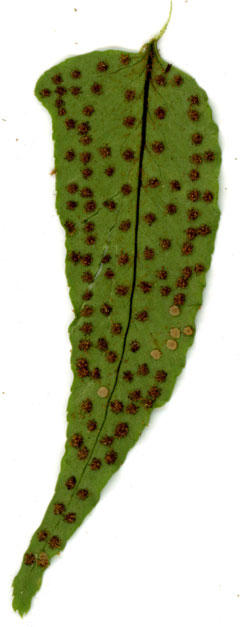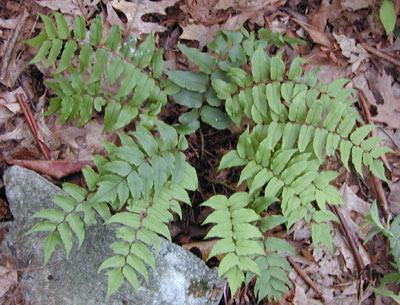|
Hardy Fern Home C. fortunei resources All Ferns � Dryopteridaceae �� Cyrtomium
�Other Genera
|
| Cyrtomium fortunei | ||
Japanese holly fern | ||
|
Etymology
Fortunei is named after the Scottish horticulturist and collector in China, Robert Fortune (1812-1890). He was responsible for spreading tea cultivation to India and Ceylon.
Description
Rhizome: erect, short, bearing several fronds in a whorl, scales oblong-ovate, gradually narrowing towards rhizome apex, rounded at base, about 1.5 cm long, 4.
Frond: 80 cm high by 20 cm wide, evergreen, monomorphic, blade/stipe ratio: . Stipe: straw-colored, scales becoming smaller and narrower in upper portion, vascular bundles: 4 or more, in an arc. Blade: 1-pinnate, lanceolate, leathery, dull green, paler beneath, glabrous. Pinnae: 10 to 20 pair, oblong to broadly lanceolate, curved upwards, to 12 cm long, 4 cm broad, pointed at apex, usually eared at base above, number of pairs highly variable; margins minutely dentate; veins netted. Sori: round, 2--4 rows at each side of costa, indusium: peltate, persistent , white, central, sporangia: brown. Culture
Habitat: mountain forests and in villages, or even on stone walls in large cities.
Distribution: Japan, Korea, southeast China, Vietnam and eastern Thailand.
Hardy to -25�C, USDA Zone 5.
Distinctive Characteristics
less glossy than the commonly grown C. falcatum, more pinnae pairs than C. caryotideum or C. macrophyllum, and smaller pinnae than either.
Synonyms
Phanerophlebia fortunei (J. Sm.) Copel. Aspidiumm falcatum var. fortunei (J. Smith) Makino Polystichum falcatum var. fortunei (J. Smith) Matsum. Polystichum fortunei (J. Smith) Nakei |
|
|
Notes
Subtaxa The Flora of Japan link lists four varieties, differing in the number of pinnae, degree of curvature, margins, and color of indusia, but all are recognizably C. fortunei.
Subtaxa The Flora of Japan link lists four varieties, differing in the number of pinnae, degree of curvature, margins, and color of indusia, but all are recognizably C. fortunei.

Cyrtomium fortunei. Pinna with ripe sori; only half a dozen indusia remain. A somewhat random distribution is common. �Scan: Tom Stuart |
